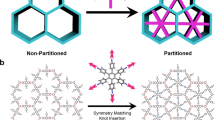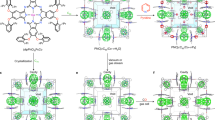Abstract
RESEARCH on microporous solids has focused largely on inorganic materials such as aluminosilicates (zeolites), aluminophosphates, pillared clays and other layered materials1,2. An elusive goal has been the design of new materials with specific properties such as selective adsorption and catalytic activity. It would be very useful if the tools of molecular synthesis could be brought to bear on this problem. Here we report the design, based on a modular approach, and the crystal structure of an organic solid with large-diameter (about 9 Å) extended channels. The channels are formed from planar, rigid macrocyclic building blocks. Onto the outer rim of the macrocycles are attached phenolic groups, which form hexagonally closest-packed two-dimensional hydrogen-bonded networks. Extended channels result from the stacking of these layers in a way that maintains registry between the macrocyclic cavities, and these channels are filled with solvent molecules. This approach potentially offers a simple means to exercise control over pore size and shape in the solid state.
This is a preview of subscription content, access via your institution
Access options
Subscribe to this journal
Receive 51 print issues and online access
$199.00 per year
only $3.90 per issue
Buy this article
- Purchase on Springer Link
- Instant access to full article PDF
Prices may be subject to local taxes which are calculated during checkout
Similar content being viewed by others
References
Ozin, G. A., Kuperman, A. & Stein, A. Angew. Chem. int. Edn engl. 28, 359–376 (1989).
Rolinson, D. R. Chem. Rev. 90, 867–878 (1990).
Zerkowski, J. A., MacDonald, J. C., Seto, C. T., Wierda, D. A. & Whitesides, G. M. J. Am. chem. Soc. 116, 2382–2391 (1994).
Chang, Y. L., West, M. A., Fowler, F. W. & Lauher, J. W. J. Am. chem. Soc. 115, 5991–6000 (1993).
Lehn, J.-M., Mascal, M., DeCian, A. & Fischer, J. J. chem. Soc., Perkin Trans. 2 461–467 (1992).
Garcia-Tellado, F., Geib, S. J., Goswami, S. & Hamilton, A. D. J. Am. chem. Soc. 113, 9265–9269 (1991).
Etter, M. C. & Adsmond, D. A. J. chem. Soc., chem. Commun. 589–591 (1990).
Michaelides, A., Kiritsis, V., Skoulika, S. & Aubury, A. Angew. Chem. int. Edn engl. 32, 1495–1497 (1993).
Simard, M., Su, D. & Wuest, J. D. J. Am. chem. Soc. 113, 4696–4698 (1991).
Ermer, O. & Eling, A. Angew. Chem. int. Edn engl. 27, 829–833 (1988).
Ermer, O. & Lindenberg, L. Helv. chim. Acta. 74, 825–877 (1991).
Hoskins, B. F. & Robson, R. J. Am. chem. Soc. 112, 1546–1554 (1990).
Duchamp, D. J. & Marsh, R. E. Acta Crystallogr. B25, 5–19 (1969).
Abrahams, B. F., Hoskins, B. F., Michail, D. M. & Robson, R. Nature 369, 727–729 (1994).
Davies, J. E., Kemula, W., Powell, H. M. & Smith, N. O. J. incl. Phenom. 1, 3–44 (1983).
Weber, E. Molecular Inclusion and Molecular Recognition-Clathrates I (ed. Weber, E.) 1 (Topics in Current Chemistry Vol. 140, Springer, Beriin, 1987).
Abbott, S. J. et al. J. chem. Soc., chem. Commun. 796–797 (1982).
Weber, E., Pollex, R. & Czugler, M. J. org. Chem. 57, 4068–4070 (1992).
Ghadiri, M. R., Granja, J. R., Milligan, R. A., Mcree, D. E. & Khazanovich, N. Nature 366, 324–327 (1993).
Zhang, J., Pesak, D. J., Ludwick, J. L. & Moore, J. S. J. Am. chem. Soc. 116, 4227–4239 (1994).
Zhang, J. & Moore, J. S. J. Am. chem. Soc. 114, 9701–9702 (1992).
Zhang, J. & Moore, J. S. J. Am. chem. Soc. 116, 2655–2656 (1994).
Sheldrick, G. M. Crystal Solution Program (Inst. fuer Anorg. Chemie, Gottingen, 1993).
Desiraju, G. R. Crystal Engineering 92–101 (Elsevier, New York, 1989).
Etter, M. C. Acc. chem. Res. 23, 120–126 (1990).
Boeyens, J. C. A. & Pretorius, J. A. Acta crystallogr. B33, 2120–2124 (1977).
Greenwood, N. N. & Earnshaw, A. Chemistry of the Elements 304 (Pergamon, Oxford, 1986).
Author information
Authors and Affiliations
Rights and permissions
About this article
Cite this article
Venkataraman, D., Lee, S., Zhang, J. et al. An organic solid with wide channels based on hydrogen bonding between macrocycles. Nature 371, 591–593 (1994). https://doi.org/10.1038/371591a0
Received:
Accepted:
Issue Date:
DOI: https://doi.org/10.1038/371591a0
This article is cited by
-
Structural details of carboxylic acid-based Hydrogen-bonded Organic Frameworks (HOFs)
Polymer Journal (2024)
-
Applications of macrocycle-based solid-state host–guest chemistry
Nature Reviews Chemistry (2023)
-
Recent advancements of photo- and electro-active hydrogen-bonded organic frameworks
Science China Chemistry (2022)
-
Molecular recognition phenomenon in aromatic compounds
Research on Chemical Intermediates (2013)
-
CoL(SO4)0.5 · 4H2O and MnL2 · 2H2O (L = 1,10-Phenanthroline-4,5-f-triazolate): Synthesis, Crystal Structures and Hydrogen-Bonded Networks
Journal of Chemical Crystallography (2008)
Comments
By submitting a comment you agree to abide by our Terms and Community Guidelines. If you find something abusive or that does not comply with our terms or guidelines please flag it as inappropriate.



